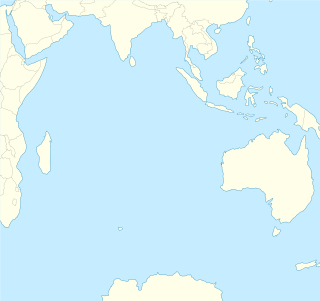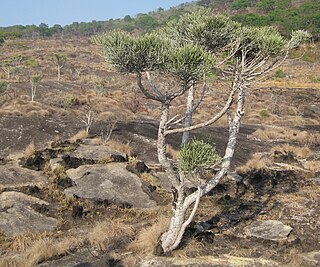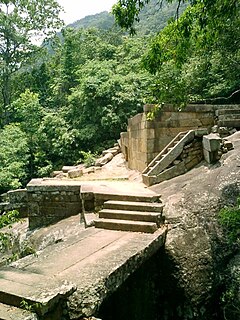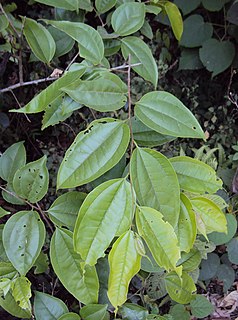
Sri Lanka, formerly called "Ceylon", is an island nation in the Indian Ocean, southeast of the Indian subcontinent, in a strategic location near major Indian Ocean sea lanes. The nation has a total area of 65,612 km², with 62,707 km² of land and 2,905 km² of water. Its coastline is 1,340 km (830 mi) long. The main island of Sri Lanka has an area of 65,268 km²; it is the twenty-fifth largest island of the world by area. Dozens of offshore islands account for the remaining 342 km² area. The largest offshore island, Mannar Island, leads to Adam's Bridge.

Tropical and subtropical moist forest (TSMF), also known as tropical moist forest, is a tropical and subtropical forest habitat type defined by the World Wide Fund for Nature. The habitat type is sometimes known as jungle.

Delonix regia is a species of flowering plant in the bean family Fabaceae, subfamily Caesalpinioideae native to Madagascar. It is noted for its fern-like leaves and flamboyant display of orange-red flowers over summer. In many tropical parts of the world it is grown as an ornamental tree and in English it is given the name royal poinciana, flamboyant, flame of the forest, or flame tree.

Ficus microcarpa, also known as Chinese banyan, Malayan banyan, Indian laurel, curtain fig, or gajumaru (ガジュマル), is a tree in the fig family Moraceae. It is native in a range from China through tropical Asia and the Caroline Islands to Australia. It is widely planted as a shade tree and frequently misidentified as F. retusa or as F. nitida.

Thespesia populnea, commonly known as the portia tree, Pacific rosewood, Indian tulip tree, or milo, among other names, is a species of flowering plant belonging to the mallow family, Malvaceae. It is a tree found commonly in villages of Tamil Nadu and on coasts around the world. However, the Portia tree is probably native only to the Old World tropics. It was introduced to the Pacific Islands from Island Southeast Asia by prehistoric Austronesian voyagers.

Cassia fistula, commonly known as golden shower, purging cassia, Indian laburnum, or pudding-pipe tree, is a flowering plant in the subfamily, Caesalpinioideae of the legume family, Fabaceae. The species is native to the Indian subcontinent and adjacent regions of Southeast Asia. It ranges from eastward throughout India to Myanmar and Thailand and south to Sri Lanka and southern Pakistan. It is a popular ornamental plant and is also used in herbal medicine. It is both the national tree and national flower of Thailand. It is the state flower of Kerala in India.

Tectona is a genus of tropical hardwood trees in the mint family, Lamiaceae. The three species are often collectively called teak.

Miconia calvescens, the velvet tree, miconia, or bush currant, is a species of flowering plant in the family Melastomataceae. It is native to Mexico and Central and South America and it has become one of the world's most invasive species.

Euphorbia tirucalli is a tree that grows in semi-arid tropical climates. A hydrocarbon plant, it produces a poisonous latex that can cause temporary blindness.

The Sri Lanka dry-zone dry evergreen forests are a tropical dry broadleaf forest ecoregion of the island of Sri Lanka.

Monoon longifolium, the false ashoka also commonly known by its synonym Polyalthia longifolia, is an Asian small tree species in the family Annonaceae. It is native to southern India and Sri Lanka, but has been widely introduced elsewhere in tropical Asia and Africa. This evergreen tree is known to grow over 10 m. in height and is commonly planted due to its effectiveness in alleviating noise pollution. It exhibits symmetrical pyramidal growth with willowy weeping pendulous branches and long narrow lanceolate leaves with undulate margins.

Magnolia champaca, known in English as champak, is a large evergreen tree in the family Magnoliaceae. It was previously classified as Michelia champaca. It is known for its fragrant flowers, and its timber used in woodworking.

Erythrina variegata, commonly known as tiger's claw or Indian coral tree, is a species of Erythrina native to the tropical and subtropical regions of eastern Africa, the Indian Subcontinent, northern Australia, and the islands of the Indian Ocean and the western Pacific Ocean east to Fiji.

Alstonia scholaris, commonly called blackboard tree or devil's tree in English, is an evergreen tropical tree in the family Apocynaceae. It is native to southern China, tropical Asia and Australasia.

Caryota urens is a species of flowering plant in the palm family, native to Sri Lanka, India, Myanmar and Malaysia, where they grow in fields and rainforest clearings, it is regarded as introduced in Cambodia. The epithet urens is Latin for "stinging" alluding to the chemicals in the fruit. Common names in English include solitary fishtail palm, kitul palm, toddy palm, wine palm, sago palm and jaggery palm. Its leaf is used as fishing rod after trimming the branches of the leaf and drying. According to Monier-Williams, it is called moha-karin in Sanskrit. It is one of the sugar palms.
Fish toxins or fish stupefying plants have historically been used by many hunter gatherer cultures to stun fish, so they become easy to collect by hand. Some of these toxins paralyse fish, which can then be easily collected. The process of documenting many fish toxins and their use is ongoing, with interest in potential uses from medicine, agriculture, and industry.

Macaranga peltata is a plant found in northern Thailand, Sri Lanka and India. It is one of the most widely occurring early successional woody species in Sri Lanka, specially in low country wet zone. Some of the many common names include kenda - කැන්ද or kanda in Sri Lanka and chandada in India.

Ritigala is a mountain in central Sri Lanka which is home to an ancient Buddhist monastery. The ruins and rock inscriptions of the monastery date back to 1st century BCE. It is located 43 km (27 mi) away from the ancient monastic city of Anuradhapura.

Celtis timorensis, commonly known as stinkwood or stinking wood, is a species of flowering plant in the family Cannabaceae that grows in tropical Asia. The specific epithet comes from the name of the island of Timor, the locality of the type collection.

Digitaria ciliaris is a species of grass known by the common names southern crabgrass, tropical finger-grass, tropical crabgrass or summer grass.


















